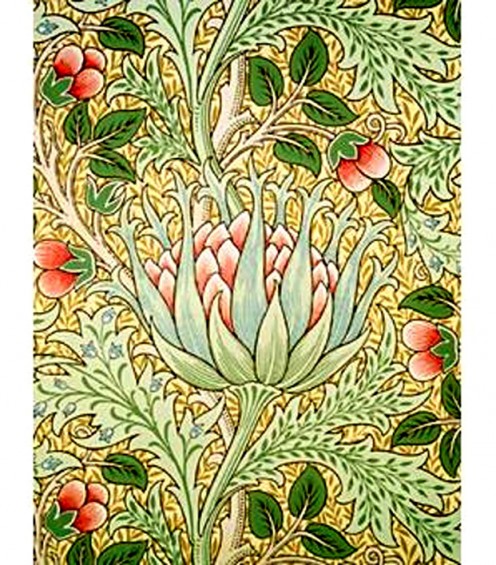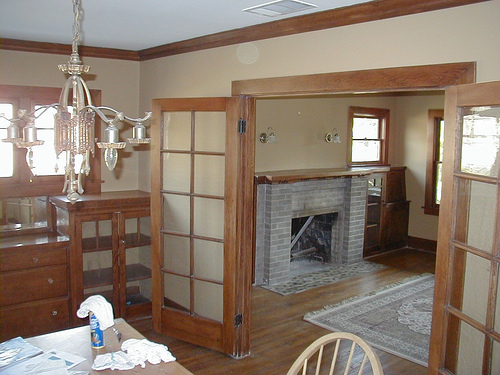Arts and Crafts Home Decorating Tips
The Arts and Crafts movement was a reaction born out of opposition to the Industrial Revolution's mechanization and mass production, as well the heavy ornamentation and excesses of the Victorian era. Arts and Crafts style originated in England and spread to the U.S. at the turn of the 20th century.
The key tenets of the Arts and Crafts movement are simplicity in design, expert craftsmanship and a close connection with nature. Common materials utilized during this time included stained glass, painted tiles, hand thrown pottery, natural wood and metals. Fabrics and wallpaper of the genre were adorned with stylized floral, animal and plant motifs.
Persons of prominence during the Arts and Crafts movement were artisans, architects and designers such as William Morris, Charles and Henry Greene, Charles Rennie Mackintosh, Gustav Stickley, Dick Van Erp, Elbert Hubbard and Frank Lloyd Wright.
Now that you know a little about the history of Arts and Crafts, here are some of the basic design elements that make up this iconic style.

Colors
Arts and Crafts emphasized colors drawn from the earth and interspersed with rich accents and textures. Warm browns inspired by natural wood tones were prevalent in Arts and Crafts interiors. Metals such as copper, burnished gold and rubbed bronze were used in making light fixtures of the era.
Other main color influences were derived from shades of indigo, quarried stone and leather. Accent colors were drawn from nature's bounty ranging from olive green, squash gold and pumpkin orange to a variety of semi-precious minerals such as amber, garnet and carnelian.

Visit California Craftsman Homes in Pasadena
Check out Pasadena's Craftsman Neighborhoods
|
|---|
Bungalow Heaven is a 16-block area that is home to a large number of modest Craftsman bungalows. It is on the National Register of Historic Places and was named Pasadena's first historic Landmark District. The neighborhood association holds an annual spring tour featuring homes, great eats, music and restoration demonstrations.
|
Pasadena Heritage holds its Annual Craftsman Weekend each October. It is the largest, all-inclusive celebration of the Arts and Crafts movement in the Western U.S. The organization holds bus and walking tours, visits to noteworthy Craftsman-era homes and an exposition show and sale with furniture and accessory exhibitors from across the country.
|
Furniture
Arts and Crafts furniture design created the perfect marriage between form and function. The artisan pieces were substantial with simple lines, deep finishes and minimal embellishment--short of burnished metal accents.
Chairs typically featured a broad back, wide set arms, a rectangular shape and leather upholstery. Tables were heavy and substantial with simple linear construction. Furniture examples of the time were rooted in the movement’s pride in handcrafted, durable products.
Originators of the Arts and Crafts movement took offense at the Victorian’s use of ornately carved woodwork and paneling. They preferred using neutral wall colors to showcase simple oak casings, trim, flooring and built-in shelving and cabinetry.
While these homes have an abundance of woodwork the look is much more straight line and organic in nature. In most Arts and Crafts homes, you’ll find the fireplace wall flanked by built-in bookcases. This functional and utilitarian use of space replaced fanciful inglenooks, popular during the Victorian era.

Lighting
Overhead lighting and lamps in Arts and Crafts homes were basic in design and most likely made from copper or brass. Reflective and delicate mica shades were the perfect counterpoint to these hard metal fixtures.
Craftsman and Mission lighting uses a range of bronze, black and weathered antique finishes paired with amber glass or mosaics to create a warm atmosphere. Tiffany glass was used in many hanging and table lamp shades. Classic glass patterns feature simple geometric designs as well as wheat sheaths and a variety of organic elements.
Chandeliers and ceiling mounted lights feature clean, simple lines with minimal scrollwork and adornments. Arts and Crafts is a truly American style that is considered functional and welcoming which makes it perfect for today's lifestyles.

Pottery
Handmade decorative pottery was all the rage during the Arts and Crafts movement. This is one area that combined mass production and handmade artistry. In order to make functional and decorative ceramics that were affordable, ceramics companies commissioned artists to design the pieces, used mechanized production techniques and hired skilled painters to develop unique colors and finishes.
Rookwood, Roseville, Weller and Van Briggle are just a few of the pottery companies that were well-known for their contributions to the Arts and Crafts movement. Even today, these pieces are still in great demand and highly collectible.

Arts and Crafts Decorating Do's
Do
| Leave woodwork intact
|
Do
| Strip old paint from woodwork and use a wood stain
|
Do
| Use a nature-inspired color palette
|
Do
| Invest in period or quality reproduction furniture, light fixtures and hardware
|
Do
| Keep spaces free of clutter
|
Do
| Stay true to the original design aesthetic
|

Arts and Crafts Decorating Don'ts
Don't
| Fill spaces with too much furniture and accessories
|
Don't
| Mix styles
|
Don't
| Paint over a brick or stone fireplace
|
Don't
| Use bright colors
|
Don't
| Install wall-to-wall carpeting
|
Don't
| Fill the walls with artwork
|
© 2013 Linda Chechar








